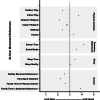Impact of the COVID-19 virus outbreak on movement and play behaviours of Canadian children and youth: a national survey
- PMID: 32631350
- PMCID: PMC7336091
- DOI: 10.1186/s12966-020-00987-8
Impact of the COVID-19 virus outbreak on movement and play behaviours of Canadian children and youth: a national survey
Abstract
Background: Healthy childhood development is fostered through sufficient physical activity (PA; including time outdoors), limiting sedentary behaviours (SB), and adequate sleep; collectively known as movement behaviours. Though the COVID-19 virus outbreak has changed the daily lives of children and youth, it is unknown to what extent related restrictions may compromise the ability to play and meet movement behaviour recommendations. This secondary data analysis examined the immediate impacts of COVID-19 restrictions on movement and play behaviours in children and youth.
Methods: A national sample of Canadian parents (n = 1472) of children (5-11 years) or youth (12-17 years) (54% girls) completed an online survey that assessed immediate changes in child movement and play behaviours during the COVID-19 outbreak. Behaviours included PA and play, SB, and sleep. Family demographics and parental factors that may influence movement behaviours were assessed. Correlations between behaviours and demographic and parental factors were determined. For open-ended questions, word frequency distributions were reported.
Results: Only 4.8% (2.8% girls, 6.5% boys) of children and 0.6% (0.8% girls, 0.5% boys) of youth were meeting combined movement behaviour guidelines during COVID-19 restrictions. Children and youth had lower PA levels, less outside time, higher SB (including leisure screen time), and more sleep during the outbreak. Parental encouragement and support, parental engagement in PA, and family dog ownership were positively associated with healthy movement behaviours. Although families spent less time in PA and more time in SB, several parents reported adopting new hobbies or accessing new resources.
Conclusions: This study provides evidence of immediate collateral consequences of the COVID-19 outbreak, demonstrating an adverse impact on the movement and play behaviours of Canadian children and youth. These findings can guide efforts to preserve and promote child health during the COVID-19 outbreak and crisis recovery period, and to inform strategies to mitigate potential harm during future pandemics.
Conflict of interest statement
SAM, MB, RM have no conflicts of interest to declare. GF, RER, LJF, NO, JCS, and MST are members of the ParticipACTION Research Advisory Group (RAG). The RAG provides advice to ParticipACTION about the direction that should be pursued with respect to its research, evaluation, and knowledge translation. ParticipACTION provides meeting expenses for the RAG to meet but does not provide any additional compensation. TCB and LMV are employed by ParticipACTION in the roles of Behavioural Insights Manager and Knowledge Translation Manager, respectively.
Figures

References
-
- World Health Organization . WHO guidelines on physical activity, sedentary behaviour and sleep for children under 5 years of age. 2019. - PubMed
MeSH terms
LinkOut - more resources
Full Text Sources
Medical

